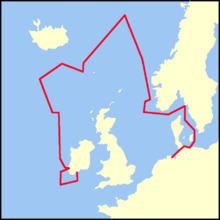Name SS Castro Name Libau (Aud) Fate Scuttled 1916 Draft 3.7 m | Laid down 1907 Acquired 1914 Length 67 m | |
 | ||
Fate Captured by Imperial German Navy 1914 | ||
Libau ( [lɪˈbaʊ]; also known as SS Castro) was a merchant steam ship. In 1916 it masqueraded under the cover name of Aud ([ʔaʊ̯d]) in an attempt to carry arms to Ireland as part of the preparation for the Easter Rising.
Contents
Vessel
SS Castro was a 1,062 ton steam cargo transport built for the Wilson Line of Hull, England in 1907. Castro measured 220 feet (67 m) in length with a beam 32 feet (9.8 m) and a draught of 12 ft (3.7 m). The ship was captured by the Imperial German Navy in the Kiel Canal, at the beginning of World War I in August 1914. Renamed Libau (the German name of Liepāja), she remained inactive until 1916, when designated as the vessel to carry a cargo of arms to Ireland, to aid the Easter Rising, and given the name Aud.
Smuggling operation
Masquerading as SS Aud —an existing Norwegian vessel of similar appearance— Libau set sail from the Baltic port of Lübeck on 9 April 1916, under the Command of Karl Spindler, bound for the south-west coast of Ireland. Under Spindler was a crew of 22 men, all of whom were volunteers. Libau/Aud, laden with an estimated 20,000 rifles, 1,000,000 rounds of ammunition, 10 machine guns, and explosives (under a camouflage of a timber cargo), evaded patrols of both the British 10th Cruiser Squadron and local Auxiliary patrols.
After surviving violent storms off Rockall, Libau arrived in Tralee Bay on 20 April. There they were due to meet with Roger Casement and others, with Casement having been landed nearby by the German submarine U-19. Due to a combination of factors (primarily as the ship carried no radio and was unaware that the date for its arrival off Fenit had been altered from Thursday, 20 April to Sunday, 23 April) the transfer of arms did not take place. Libau, attempting to escape the area, was trapped by a blockade of British ships. Captain Spindler allowed himself to be escorted towards Cork Harbour, in the company of the Acacia-class sloop HMS Bluebell. The German crew then scuttled the ship.
Spindler and crew were interned for the duration of the war.
At this point Roger Casement and his companions who had been landed by the submarine U-19 in Kerry had been captured in an old ringfort or rath, between Ardfert and Tralee .
One of the two car-loads of Volunteers who were supposed to meet Spindler had crashed into the River Laune, many miles away, at Ballykissane pier, Killorglin, (resulting in the death of three of the four occupants of the car) so there was no hope of an organised transfer of arms. With Spindler and his crew on a ship with no radio or other means of communicating their plight the poorly organised gun-running plan was nearing an end.
"Aud rifles"
A number of rifles were recovered from Libau before the vessel was scuttled. Several examples exist in various museums in Britain and Ireland. Among these are the Cork Public Museum in Fitzgerald's Park in Cork, a museum in Lurgan County Armagh, the National Museum of Ireland in Dublin, and the Imperial War Museum in London. The majority of these rifles are the model known as the Mosin–Nagant 1891, or "three-line rifle", captured in the German rout of Russian forces in the Battle of Tannenberg. These rifles have been referred to in various publications as being 'outmoded and out of date;' however they were comparable with other leading models of the era. They were a different calibre from German rifles and therefore, for logistic reasons, the Germans preferred not to issue them for the use of their own troops. They were magazine rifles, which enabled the user to pre-load five rounds from a clip plus, if needed, one more in the breech, and then fire accurately in reasonably rapid succession, using relatively modern .30 calibre ( in millimetres 7.62×54mmR ) spitzer-nosed bullets. Per Russian preference, the rifles aboard Libau were equipped with the Russian model of socket bayonets, s.c. "Rat-tails".
Anchors
In 2012, a licensed salvage operation raised Aud's anchors from the wreck site outside the entrance to Cork Harbour at Daunt Rock. Following conservation and desalination works, the anchors were put on public display.
